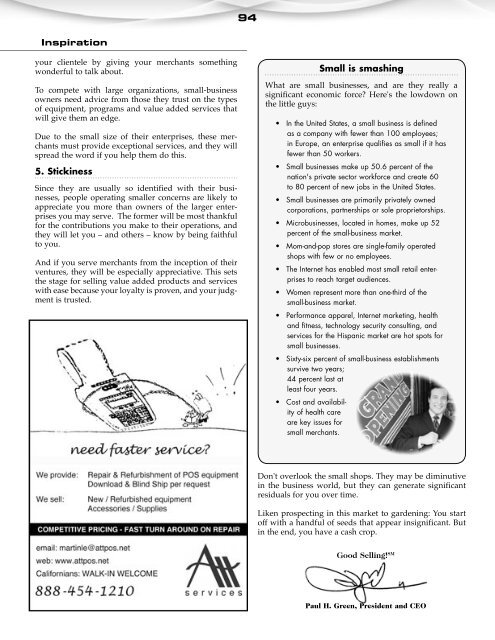View PDF of this issue - The Green Sheet
View PDF of this issue - The Green Sheet
View PDF of this issue - The Green Sheet
You also want an ePaper? Increase the reach of your titles
YUMPU automatically turns print PDFs into web optimized ePapers that Google loves.
94<br />
Inspiration<br />
your clientele by giving your merchants something<br />
wonderful to talk about.<br />
To compete with large organizations, small-business<br />
owners need advice from those they trust on the types<br />
<strong>of</strong> equipment, programs and value added services that<br />
will give them an edge.<br />
Due to the small size <strong>of</strong> their enterprises, these merchants<br />
must provide exceptional services, and they will<br />
spread the word if you help them do <strong>this</strong>.<br />
5. Stickiness<br />
Since they are usually so identified with their businesses,<br />
people operating smaller concerns are likely to<br />
appreciate you more than owners <strong>of</strong> the larger enterprises<br />
you may serve. <strong>The</strong> former will be most thankful<br />
for the contributions you make to their operations, and<br />
they will let you – and others – know by being faithful<br />
to you.<br />
And if you serve merchants from the inception <strong>of</strong> their<br />
ventures, they will be especially appreciative. This sets<br />
the stage for selling value added products and services<br />
with ease because your loyalty is proven, and your judgment<br />
is trusted.<br />
Small is smashing<br />
What are small businesses, and are they really a<br />
significant economic force? Here's the lowdown on<br />
the little guys:<br />
• In the United States, a small business is defined<br />
as a company with fewer than 100 employees;<br />
in Europe, an enterprise qualifies as small if it has<br />
fewer than 50 workers.<br />
• Small businesses make up 50.6 percent <strong>of</strong> the<br />
nation's private sector workforce and create 60<br />
to 80 percent <strong>of</strong> new jobs in the United States.<br />
• Small businesses are primarily privately owned<br />
corporations, partnerships or sole proprietorships.<br />
• Microbusinesses, located in homes, make up 52<br />
percent <strong>of</strong> the small-business market.<br />
• Mom-and-pop stores are single-family operated<br />
shops with few or no employees.<br />
• <strong>The</strong> Internet has enabled most small retail enterprises<br />
to reach target audiences.<br />
• Women represent more than one-third <strong>of</strong> the<br />
small-business market.<br />
• Performance apparel, Internet marketing, health<br />
and fitness, technology security consulting, and<br />
services for the Hispanic market are hot spots for<br />
small businesses.<br />
• Sixty-six percent <strong>of</strong> small-business establishments<br />
survive two years;<br />
44 percent last at<br />
least four years.<br />
• Cost and availability<br />
<strong>of</strong> health care<br />
are key <strong>issue</strong>s for<br />
small merchants.<br />
Don't overlook the small shops. <strong>The</strong>y may be diminutive<br />
in the business world, but they can generate significant<br />
residuals for you over time.<br />
Liken prospecting in <strong>this</strong> market to gardening: You start<br />
<strong>of</strong>f with a handful <strong>of</strong> seeds that appear insignificant. But<br />
in the end, you have a cash crop.
















